Potential obstacle can be circumvented through selective breeding
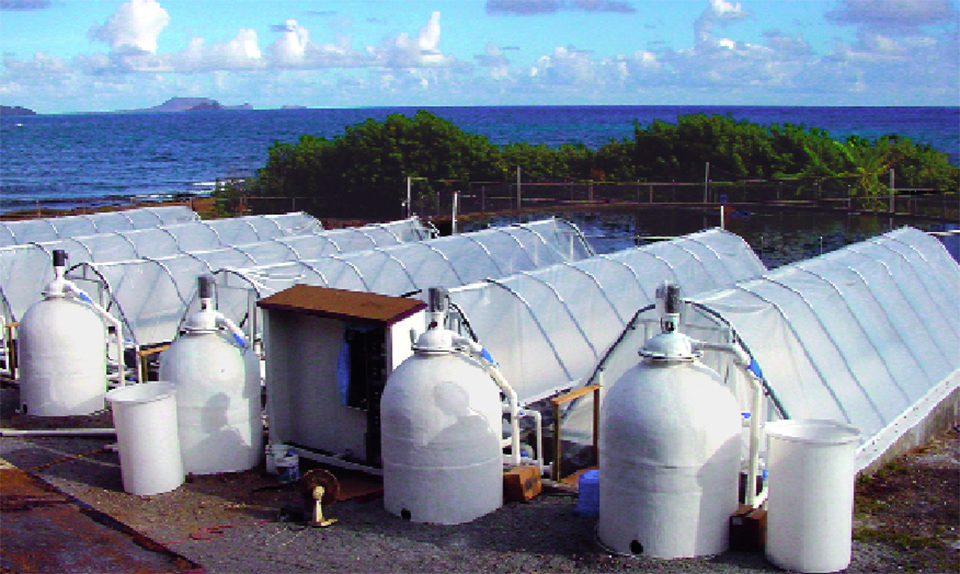
Anecdotal reports and experimental data indicate there is an inverse relationship between stocking density and shrimp performance in aquaculture. Shrimp stocked at higher densities typically grow slower and exhibit lower survival than shrimp stocked at lower densities.
Most of the evidence supporting this observation comes from coastal ponds or recirculating systems with shrimp stocked at densities of less than 200 per square meter. However, little is known about the effects of stocking density on shrimp performance at super-intensive levels higher than 200 shrimp per square meter. In addition, the reasons for this inverse relationship are unclear.
We do know that at higher densities, more shrimp feed is added per unit volume of water. The increased organic load can compromise water quality and result in inferior shrimp performance, especially in recirculating systems. In addition, competitive or antagonistic shrimp behavior can account for slower growth or lower survival.
Experiment 1: stocking density
The authors recently evaluated the effects of stocking density on shrimp performance under super-intensive conditions by comparing shrimp growth and survival at 200 shrimp per square meter (267 per cubic meter – lower-density treatment) and 400 shrimp per square meter (533 per cubic meter – higher-density treatment) at Oceanic Institute in Hawaii, USA. The research was funded by a grant from the U.S. Department of Commerce, National Institute of Standards and Technology, Advanced Technology Program, and was awarded to Oceanic Institute and its research partners Genus Plc, Zeigler Brothers Inc., and Kahuku Shrimp Co.
With three replicates/treatment, juvenile Pacific white shrimp (Litopenaeus vannamei) were stocked at a mean weight of 1.12 grams in six 33-square-meter raceways covered with clear polyethylene sheeting. Protein skimmers were installed on each raceway to remove solids, and oxygen generators were used as a source of supplemental oxygen.
Ammonia and nitrite removal was accomplished by in situ microbes. No external biofilters were used. Shrimp were fed a 35 percent-protein diet, which was added to each raceway by 24-hour belt feeders. The shrimp were harvested after 86 days.
Results
Mean weight gain, growth rate, and survival were significantly higher in the lower-density treatment, whereas mean feed conversion and production were significantly higher in the higher-density treatment (Table 1). The data corroborated earlier published reports about the inverse relationship between stocking density and shrimp performance.
Otoshi, Shrimp performance data, Table 1
| Parameter | Lower Density (200/m2) | Higher Density (400/m2) |
|---|
Parameter | Lower Density (200/m2) | Higher Density (400/m2) |
|---|---|---|
| Weight gain (g) | 22.4 ± 0.92 | 17.1 ± 0.28 |
| Growth rate (g/week) | 1.71 ± 0.06 | 1.32 ± 0.02 |
| Survival (%) | 80.9 ± 2.94 | 73.3 ± 1.03 |
| Production (kg/m2) | 3.6 ± 0.23 | 5.1 ± 0.13 |
| Feed-conversion ratio | 1.7 ± 0.02 | 1.9 ± 0.01 |
Regarding water quality, there were no significant differences in mean total ammonia-nitrogen and nitrite-nitrogen concentrations between the treatments. In contrast, carbon dioxide concentrations were relatively low in all raceways during the first seven weeks of the trial, but increased rapidly in the higher-density treatment at the end of the trial (Fig. 1). It is possible that the elevated carbon dioxide concentrations had a toxic effect on the shrimp, although little is known about the effects of carbon dioxide on shrimp growth or survival.
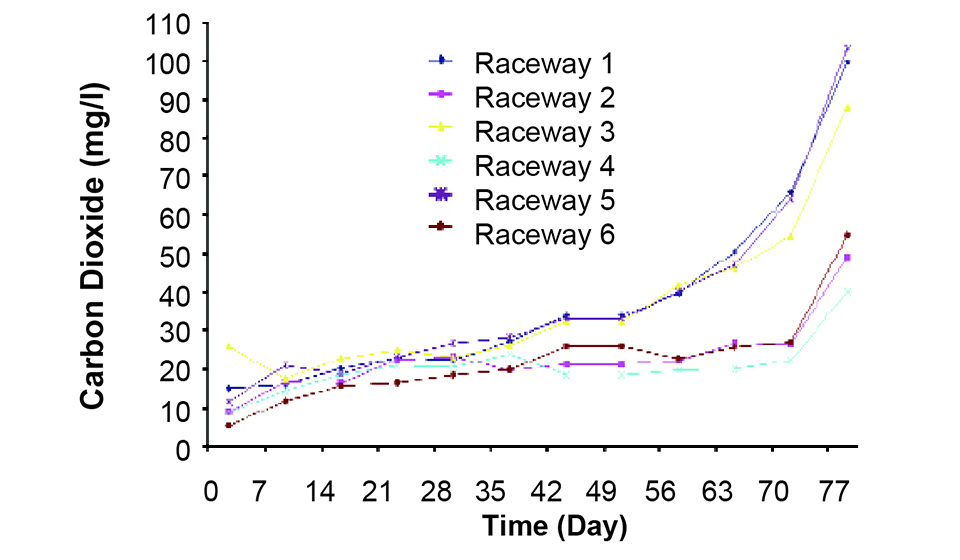
Experiment 2: density, water quality
In an effort to identify possible causes of inferior shrimp performance at higher stocking densities, Oceanic Institute researchers conducted a preliminary experiment to separate the effects of shrimp density and related behavioral effects from those of water quality.
Juvenile L. vannamei of about 3-gram weight were stocked in six, 33-square-meter raceways as described previously and exposed to four treatments as outlined in the Fig. 2 schematic diagram. Shrimp in each raceway were physically divided by 1-mm mesh screen into two populations with stocking densities of 100 or 600 per square meter. The barrier prevented movement of shrimp from one side to the other, but allowed water movement.
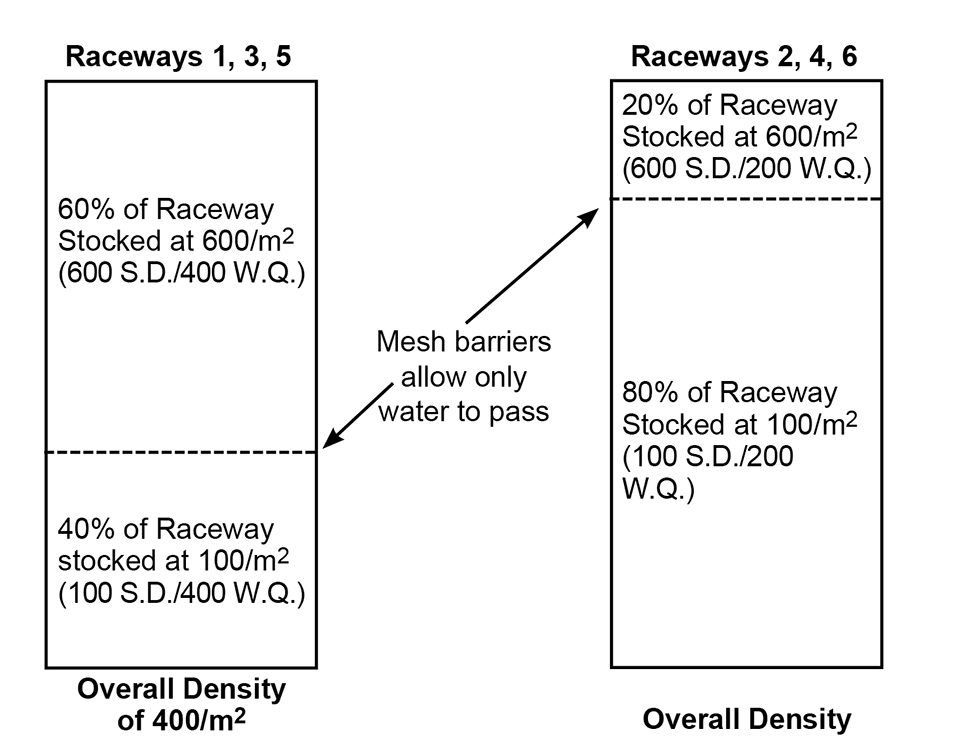
Three of the raceways had an overall stocking density of 200 per square meter, and three had an overall density of 400 per square meter. The design allowed separation of the effects of shrimp density/behavior from those of water quality on shrimp performance. The shrimp segregated at higher density effectively experienced water-quality conditions as though they were stocked at lower density.
Results
Growth data collected at week five (Fig. 3) indicated that shrimp in the lower-density 100 S.D./200 W.Q. and 100 S.D./400 W.Q. treatments grew significantly faster than shrimp in the higher-density 600 S.D./200 W.Q. and 600 S.D./400 W.Q. treatments. Mean shrimp weights (± S.D.) for the lower-density and higher-density treatments were 14.78 ± 0.71 and 11.04 ± 0.31 grams, respectively.

The figures suggested that crowding behavior associated with high density negatively impacted shrimp growth, irrespective of water quality. Water quality parameters were routinely monitored on both sides of the barrier within each raceway, and no significant differences in values were detected.
In contrast, the shrimp that experienced water quality conditions as though they were stocked at 200 per square meter (100 S.D./200 W.Q. and 600 S.D./200 W.Q.) were only slightly larger than those experiencing water quality as though they were stocked at 400 per square meter (100 S.D./400 W.Q. and 600 S.D./400 W.Q.). Mean weights (± S.D.) were 13.20 ± 2.36 and 12.65 ± 1.81 grams for the two groups, respectively. These data indicated that water quality had little effect on shrimp growth.
Behavioral effects
To our knowledge, these data represent the first reported evidence that shrimp behavior compromises growth at higher stocking densities. This potential obstacle to increased production can be circumvented through selective breeding, if relevant aspects of shrimp behavior are heritable.
Similarly, farmers may be able to employ infrastructure modifications or revised management strategies to mitigate the effects of these negative behaviors. Clearly, more research is needed to address these issues.
(Editor’s Note: This article was originally published in the March/April 2007 print edition of the Global Aquaculture Advocate.)
Now that you've reached the end of the article ...
… please consider supporting GSA’s mission to advance responsible seafood practices through education, advocacy and third-party assurances. The Advocate aims to document the evolution of responsible seafood practices and share the expansive knowledge of our vast network of contributors.
By becoming a Global Seafood Alliance member, you’re ensuring that all of the pre-competitive work we do through member benefits, resources and events can continue. Individual membership costs just $50 a year.
Not a GSA member? Join us.
Authors
-
Clete A. Otoshi, M.S.
Oceanic Institute
41-202 Kalanianaole Highway
Waimanalo, Hawaii 96795 USA -
Scott S. Naguwa
Oceanic Institute
41-202 Kalanianaole Highway
Waimanalo, Hawaii 96795 USA -
Frank C. Falesch
Oceanic Institute
41-202 Kalanianaole Highway
Waimanalo, Hawaii 96795 USA -
Shaun M. Moss, Ph.D.
Oceanic Institute
41-202 Kalanianaole Highway
Waimanalo, Hawaii 96795 USA
Tagged With
Related Posts
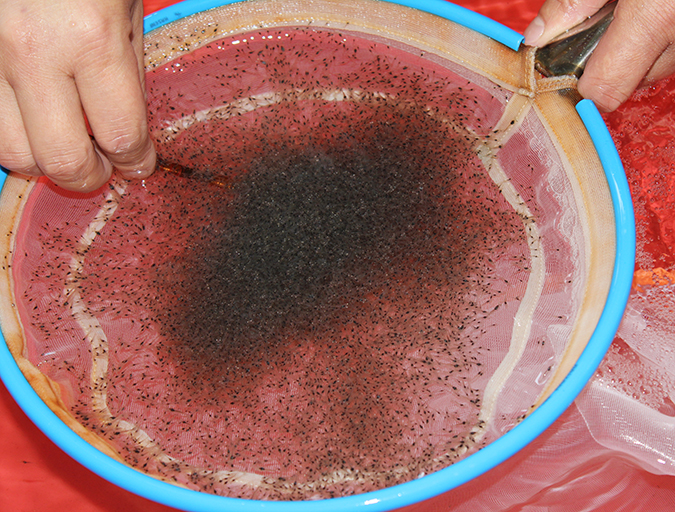
Health & Welfare
Acclimating shrimp postlarvae before pond stocking
Shrimp postlarvae acclimation before stocking into the various growout systems (ponds, raceways, tanks) is a critical – and often overlooked, sometimes taken for granted – step in the shrimp culture process. Various water quality parameters should be changed slowly so that the young shrimp have the time to gradually adapt to the new conditions.

Health & Welfare
10 paths to low productivity and profitability with tilapia in sub-Saharan Africa
Tilapia culture in sub-Saharan Africa suffers from low productivity and profitability. A comprehensive management approach is needed to address the root causes.

Responsibility
A look at various intensive shrimp farming systems in Asia
The impact of diseases led some Asian shrimp farming countries to develop biofloc and recirculation aquaculture system (RAS) production technologies. Treating incoming water for culture operations and wastewater treatment are biosecurity measures for disease prevention and control.
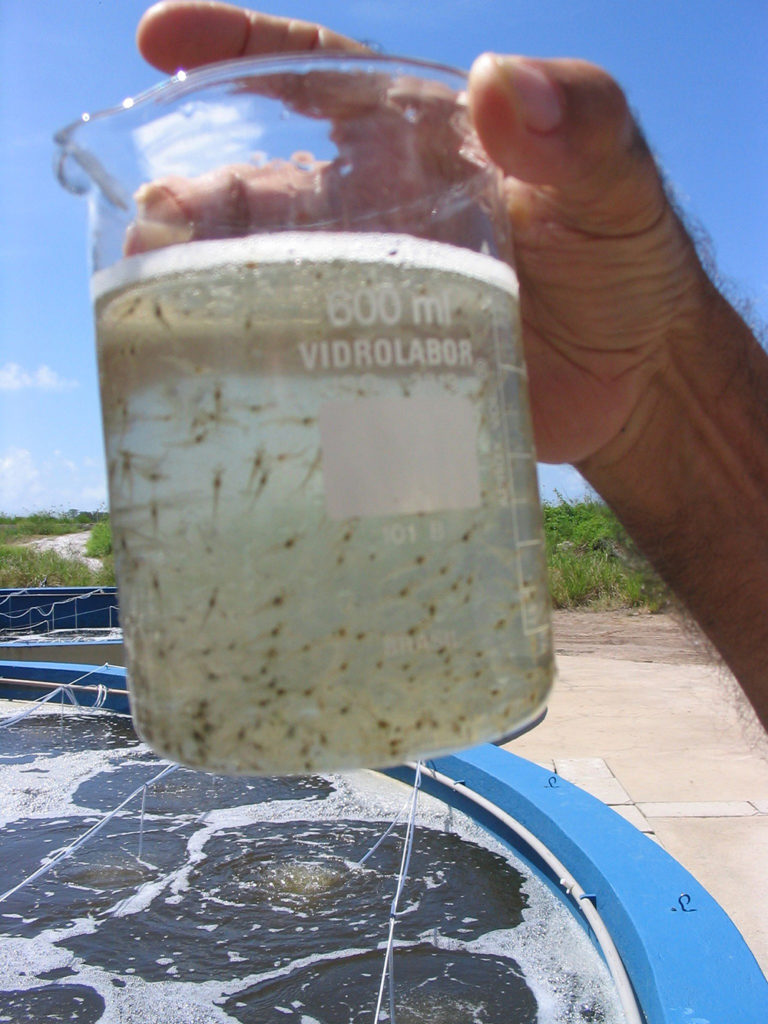
Health & Welfare
A study of Zoea-2 Syndrome in hatcheries in India, part 2
Indian shrimp hatcheries have experienced larval mortality in the zoea-2 stage, with molt deterioration and resulting in heavy mortality. Authors considered biotic and abiotic factors. Part 2 describes results of their study.


